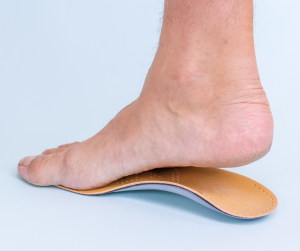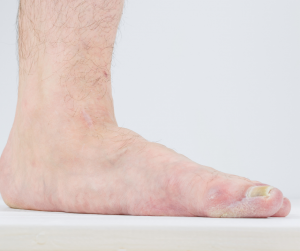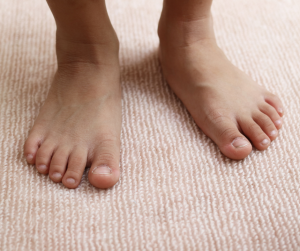
 If you have flat feet, knowing which insoles are right for your feet can be difficult and confusing. There are so many types out there, which may leave you with a lot more questions than answers, like:
If you have flat feet, knowing which insoles are right for your feet can be difficult and confusing. There are so many types out there, which may leave you with a lot more questions than answers, like:
- How do I tell the difference between the different types of insoles – they all look the same?
- Which are the best insoles for me and my feet?
- How do I know if the insoles I have now are right for me?
- Is my foot or leg pain because of my flat feet?
- Am I going to get foot problems because of my flat feet – and would insoles help?
These are great and valid questions, and our podiatrists have set out to answer them all by explaining what having flat feet really mean for you – and where insoles fit into the picture.
Is Having Flat Feet Bad?
Flat feet are shown to occur in less than 30% of adults. While the majority of people tend to have flat feet naturally as a result of their foot posture and biomechanics, some can experience an arch collapse from injuries and problems like posterior tibial tendon dysfunction (PTTD), charcot foot, pregnancy, and more.
 As the foot rolls inwards (pronates) to a much greater extent every time you take a step, this increases your likelihood of developing an overuse injury like plantar fasciitis heel pain, where the ligaments, muscles or tendons in your feet and stressed beyond what they can safely handle, leading to micro-tears, damage and pain.
As the foot rolls inwards (pronates) to a much greater extent every time you take a step, this increases your likelihood of developing an overuse injury like plantar fasciitis heel pain, where the ligaments, muscles or tendons in your feet and stressed beyond what they can safely handle, leading to micro-tears, damage and pain.
It’s also important to note that at times, appearances may be deceiving. You may have a foot that appears to have a low arch, but pronates and supinates (rolls out) adequately, or you may have a foot that appears to have a good arch when you lift it up and look at it, but flattens almost completely when it comes in contact with the ground, resulting in severe overpronation and strain. This is why it’s important to have your feet professionally assessed, so you know exactly what’s happening with your feet and your unique risks.
With all this said, while your risk may be increased, this does not mean that you are destined to develop foot pain and problems. As podiatrists, we know many people in our lives that have flat feet but don’t experience any foot pain as, for example, they may be hypermobile and less likely to strain their tissues. They may get more tiredness and aches after going for a long walk or hike, but don’t suffer otherwise.
So, Which Insoles Are Best For My Feet?
We get it – they all look the same, right? If you’re browsing the selection at your pharmacy, then that’s likely the case. You’ll see some that are softer, some that are firmer, some with extra colourful bits around the heel or the ball of the foot, and so on.
Knowing which one is going to be the best for your feet is almost impossible – because these have all been pre-made without any consideration to the unique characteristics of your feet – or any problems or discomforts you’re having. All they know is that you have flat feet – but how flat? They don’t know whether you’re rolling in slightly or have pancake-flat feet, nor what level of support is going to be most comfortable for you (supportive, but not aggressive). They also don’t consider what shoes you’re going to be wearing them in. Do your joggers already have some in-built support? Are your work shoes narrow and the insole is just going to cramp your feet all day?
All of those points are very important in choosing the best orthotics for you, yet they’ve had zero consideration when you go to select a pair from a shop or order them online.
Custom Insoles Solve All These Problems
This is where custom insoles come in to solve all these problems. By custom, we mean those that have been prescribed specifically for your feet, the way your bones, muscles, joints and ligaments all move together, your footwear at work and during exercise, and how much standing or walking you do at work (which will wear down soft orthotics very quickly!). Most importantly, they will be designed with the right features to help alleviate your pain, correct your problem, and achieve your goal. To name a few, this may be to:
- Recover from heel pain
- Stop getting tired, achy legs at the end of your work shift
- Run for longer
Custom Insoles Are Made For Your Feet
 Custom foot orthotics are intricately made for your feet by having a biomechanical assessment and 3D foot scan with your podiatrist. This takes approximately one hour to complete and involves getting to know your medical and injury history, and conducting an extensive physical and stance assessment (standing, walking and lying down), as well as comprehensive video gait analysis on a treadmill.
Custom foot orthotics are intricately made for your feet by having a biomechanical assessment and 3D foot scan with your podiatrist. This takes approximately one hour to complete and involves getting to know your medical and injury history, and conducting an extensive physical and stance assessment (standing, walking and lying down), as well as comprehensive video gait analysis on a treadmill.
Your podiatrist then takes your results, your problems and your goals, and uses years of experience to create a custom prescription of what insole features will help you get the best results. This prescription is then combined with your 3D foot scan to create a completely unique set of insoles that have the right fit, materials, sizing and beneficial features. Once made, these are then fitted perfectly to your shoes by our team, ensuring that the shoes and insoles work brilliantly together to produce the results you want!
Your Orthotics Can Be The Difference Between Ongoing Pain Or Comfort And Recovery
While it may seem like a simple decision at a shop, the truth is that the insoles we create can make all the difference between whether our patients are able to recover quickly from injury and continue to stay comfortable and pain-free on their feet, or whether they may feel a little more cushioned, but their problems and frustrations continue to linger until they finally decide to take action and seek help from their podiatrist.
Custom insoles are our speciality, and we’re proud to have our own orthotics lab and manufacturing services – meaning we get them exactly how we want them, and aren’t restrained by the technology or abilities of others.
Book your appointment with our experienced podiatry team by calling us on 1800 FOOT DR or book your appointment online. Learn more about custom foot insoles and how they’re made here.


